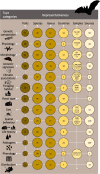A species-level trait dataset of bats in Europe and beyond
- PMID: 37137926
- PMCID: PMC10156679
- DOI: 10.1038/s41597-023-02157-4
A species-level trait dataset of bats in Europe and beyond
Abstract
Knowledge of species' functional traits is essential for understanding biodiversity patterns, predicting the impacts of global environmental changes, and assessing the efficiency of conservation measures. Bats are major components of mammalian diversity and occupy a variety of ecological niches and geographic distributions. However, an extensive compilation of their functional traits and ecological attributes is still missing. Here we present EuroBaTrait 1.0, the most comprehensive and up-to-date trait dataset covering 47 European bat species. The dataset includes data on 118 traits including genetic composition, physiology, morphology, acoustic signature, climatic associations, foraging habitat, roost type, diet, spatial behaviour, life history, pathogens, phenology, and distribution. We compiled the bat trait data obtained from three main sources: (i) a systematic literature and dataset search, (ii) unpublished data from European bat experts, and (iii) observations from large-scale monitoring programs. EuroBaTrait is designed to provide an important data source for comparative and trait-based analyses at the species or community level. The dataset also exposes knowledge gaps in species, geographic and trait coverage, highlighting priorities for future data collection.
© 2023. The Author(s).
Conflict of interest statement
The authors declare no competing interests.
Figures




References
-
- Violle C, et al. Let the concept of trait be functional! Oikos. 2007;116:882–892. doi: 10.1111/j.0030-1299.2007.15559.x. - DOI
-
- Lavorel S, Garnier E. Predicting changes in community composition and ecosystem functioning from plant traits: revisiting the Holy Grail. Functional Ecology. 2002;16:545–556. doi: 10.1046/j.1365-2435.2002.00664.x. - DOI
-
- Zakharova L, Meyer K, Seifan M. Trait-based modelling in ecology: a review of two decades of research. Ecological Modelling. 2019;407:108703. doi: 10.1016/j.ecolmodel.2019.05.008. - DOI
Publication types
MeSH terms
Grants and funding
LinkOut - more resources
Full Text Sources

